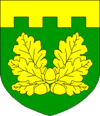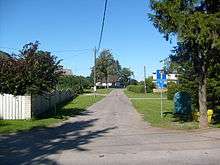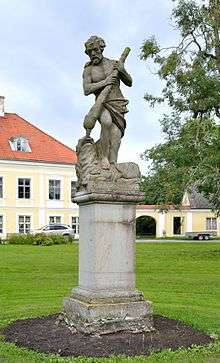Saue
Saue is a town in north-western Estonia. It's the administrative centre of Saue Parish in Harju County.
Saue | |
|---|---|
.jpg) Saue Manor | |
 Flag  Coat of arms | |
| Country | Estonia |
| County | Harju County |
| Municipality | Saue Parish |
| Area | |
| • Total | 3.49 km2 (1.35 sq mi) |
| Population (2017) | |
| • Total | 5,810 |
| • Rank | 21st |
| Ethnicity | |
| • Estonians | 93.3% |
| • Russians | 4.6% |
| • other | 2.1% |
| Time zone | UTC+2 (EET) |
| • Summer (DST) | UTC+3 (EEST) |
The territory of Saue is 3.50 square kilometres (1.35 sq mi) and population about 5,800. Closest centres are Tallinn (18 km (11 mi)), Keila (7 km (4 mi)), Saku (7 km (4 mi)) and Laagri (7 km (4 mi)).
Geography
Saue is located at a very favourable position near Tallinn, the capital of Estonia. It lures a lot of moderately wealthy people who like the balance between the small town and big city atmosphere. While Saue is close to nature, it still provides the kinds of entertainment, jobs, and other big city amenities that Tallinn has to offer.
History
- 1620s – Saue manor (Klein-Sauß) was established
- 1792 - The current manor house was built
- 1870 - The Saint Petersburg–Tallinn–Paldiski railway passing Saue was completed
- 1920s – Garden settlement started to arise
- 1960s – Saue was united with Tallinn
- 1973 – Saue, still part of Tallinn, gained a borough (alev) status
- 1993 – Saue was granted the town rights
- 1994 – Saue was separated from Tallinn and given a separate urban municipality status
- 2017 – Saue town, Saue Parish, Kernu Parish and Nissi Parish were united and a new Saue Parish was formed

Population
93% of the people living in Saue are ethnic Estonians. The average age of people is 35. Over the years, the census of the population has shown that the population is slowly growing. In 1959 there were 1,088 people living in Saue, by 1970 it had increased to 1,979. In 1979 it was 3,293, in 1989 the population was 4,395, in 1995 it was 4,492 and finally, by 2000, the population was 4,996.
Economy
In Saue there is 1.30 square kilometres (0.50 sq mi) of private plots (average size of a plot is about 700 m2 (7,500 sq ft)) – 1015 plots, about 0.35 km2 (0.14 sq mi) of communal buildings, garages etc., 0.25 km2 (0.097 sq mi) of industrial areas, Streets and roads about 0.30 km2 (0.12 sq mi) (there are 62 streets in Saue – about 21 km (13 mi)), about 1.12 km2 (0.43 sq mi) of forests, parks etc. and about 0.15 km2 (0.058 sq mi) of fields.

Transport
Saue has a stop on the Tallinn-Keila railway line (serviced by Elron), as well as bus connections and fixed-route taxis.
Saue Manor
Saue Manor (German: Friedrichshof) traces its origins to at least the 17th century. The current building was erected when the estate was owned by Friedrich Hermann von Fersen.[1] The architect was very probably Johann Schultz, who was also the architect behind the baroque extension of Toompea Castle, Tallinn.[2] The manor house complex is one of the finest examples of baroque manor house architecture in Estonia.
The exterior of the main house is characterised by a ground storey with rustications and a pilastered main floor. Wings (a stable-coach house and a granary) are linked to the main building via arched walls. The remains of a baroque park surrounds the manor, with noteworthy details such as sculptures of Heracles and Hera, and baroque sculptured reliefs.[3][4]
The interior is noteworthy for its very rich display of stucco decorations of high quality in late baroque-early neoclassicist style. Stucco decorations adorn all the main rooms of the manor. Additionally, there are fine baroque cocklestoves in the manor.[5][6]
Notable people
- Ingemar Teever (born 1983), football player
References
- Hein, Ants (2009). Eesti Mõisad - Herrenhäuser in Estland - Estonian Manor Houses. Tallinn: Tänapäev. p. 32. ISBN 978-9985-62-765-5.
- "Toompea Castle: History". Parliament of Estonia. Retrieved 22 December 2012.
- Sakk, Ivar (2004). Estonian Manors - A Travelogue. Tallinn: Sakk & Sakk OÜ. pp. 42–43. ISBN 9949-10-117-4.
- Viirand, Tiiu (2004). Estonia. Cultural Tourism. Kunst Publishers. pp. 55–56. ISBN 9949-407-18-4.
- Sakk, Ivar (2004). Estonian Manors - A Travelogue. Tallinn: Sakk & Sakk OÜ. pp. 42–43. ISBN 9949-10-117-4.
- Viirand, Tiiu (2004). Estonia. Cultural Tourism. Kunst Publishers. pp. 55–56. ISBN 9949-407-18-4.
External links
| Wikimedia Commons has media related to Saue. |
- Official website
- Saue manor official site
- Saue manor at Estonian Manors Portal
- Saue manor picture gallery at Visit Estonia